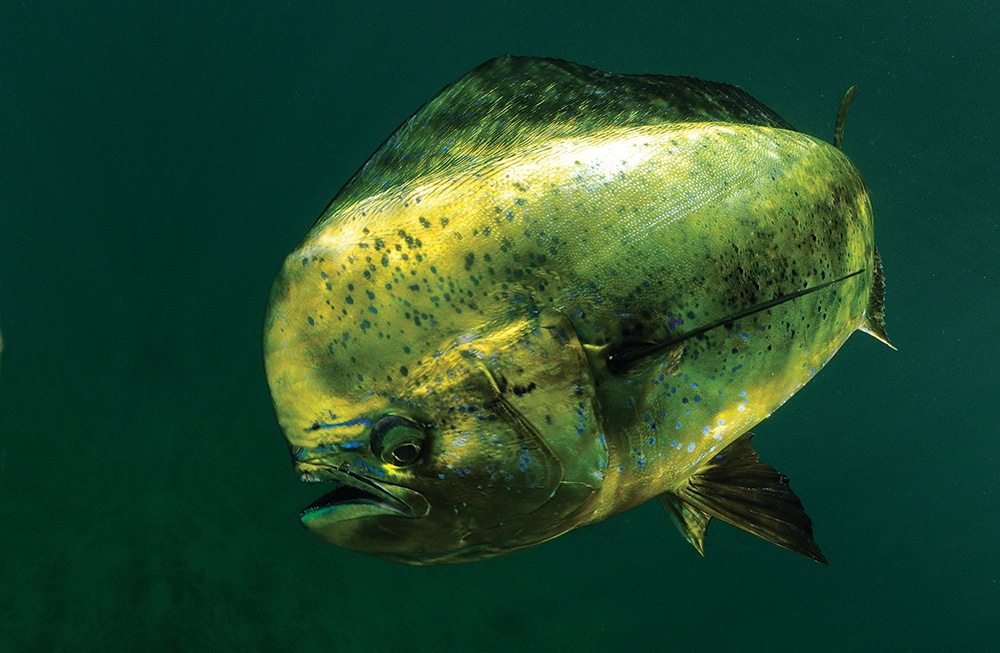
Nature’s gift to offshore fishermen is the circumtropical mahimahi. For anglers, Coryphaena hippurus is both a worthy adversary on the troll — with its high-flying and unpredictable jumps — and a welcome sight around drifting flotsam.
A distance-swimming pelagic star, dolphin patrol the tropical and subtropical waters of the Atlantic, Indian and Pacific oceans eating anything that fits within their jaws.
Trek north or south from the equator along the Americas, and dolphin are available anywhere between the latitudes of 46°N and 38°S. Travel east around the world, and the species distribution expands even farther toward the poles, seasonally covering all waters around Africa, the Bay of Biscay and Mediterranean Sea in Europe, southern waters of Asia, and the whole of Australia. As long as sea-surface temperatures hover around 78 to 84 degrees F, the brightly colored neons are a probable catch.
Not many game fish can claim that kind of real estate. And not many fish have so many different names to refer to the exact same species. Because of its impact on offshore anglers, a better understanding of the dolphin species and its life history is important for any fisherman targeting them.
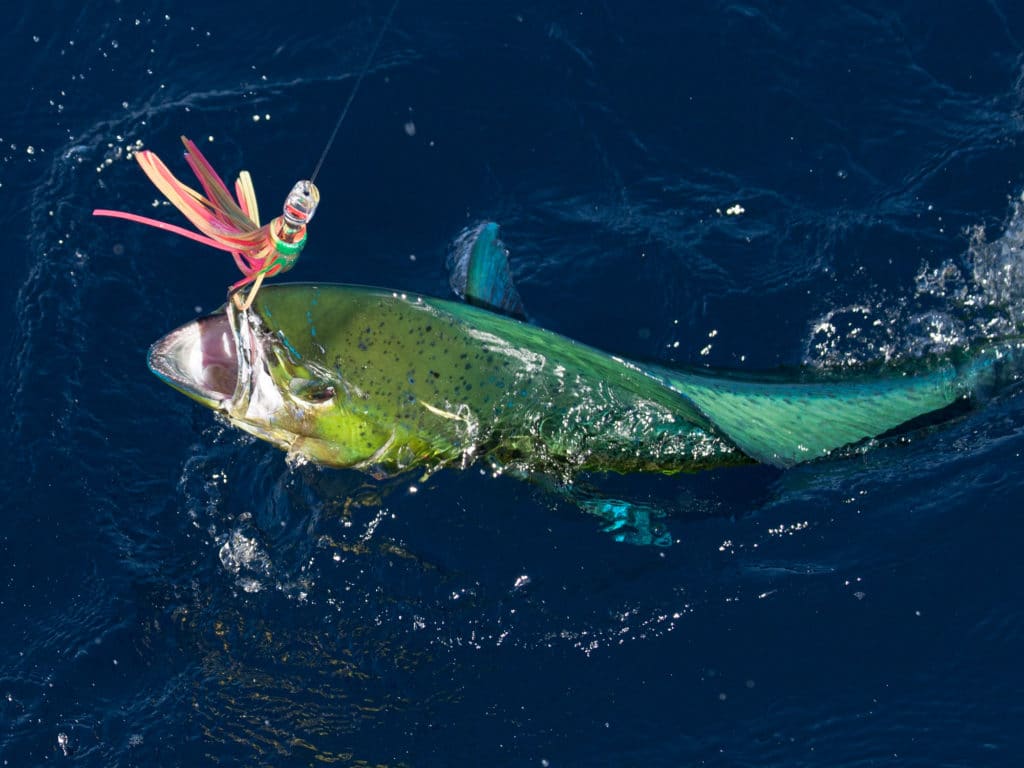
Long-Range Swimming Fish
To show the extreme distances that mahi travel, look no further than current research by Don Hammond, who heads up the Dolphinfish Research Program based in South Carolina. Since 2002, he’s tracked dolphin movements all along the U.S. East Coast and the tropics with help from recreational fishermen and pop-up satellite tags. The majority of fish for the program are tagged off South Florida and the Keys due to higher fishing pressure, but he’s continually receiving new data that change our understanding of western Atlantic migration movements.
“Recaptures have shown that dolphin continuously move northward along the U.S. Atlantic coast, riding the ocean currents, and disappearing for short periods before showing up in tropical regions,” says Hammond. “Some individuals make a circum-Atlantic migration that encompasses 8,000 miles or more. Fish that travel to the Atlantis Canyon area off New York commonly turn southeast, traveling past Bermuda, before catching a southerly current back to the tropics.”
Not enough fishermen realize that the waters of the Northeast are a dolphin destination — they are definitely available during certain times of the year.
“We catch them off the Delmarva Peninsula, usually trolling weed lines and floating debris like dunnage jettison from cargo ships,” says Capt. Jim Mahoney, of Blue Collar Man Sportfishing in Indian River, Delaware. “We have caught them in water as cold as 67 degrees, but I typically look for at least 70 degrees and clear, blue water.”
Hammond believes that as the oceans gradually warm from global climate change, dolphinfish will likely become more prevalent in the Mid-Atlantic Bight. His data suggest that dolphin in the western north Atlantic Ocean are a single stock, with fish tagged off the U.S. coast reappearing off Cuba, Puerto Rico, Antigua, Venezuela and Mexico. Fish that travel the East Coast come from any number of routes, including the east side of the Bahamas Bank or the Old Bahamas Channel, and from the west via the Loop Current in the Gulf of Mexico. In particular, dolphin from the eastern Bahamas replenish numbers on the west side of the Gulf Stream near the Carolinas, according to Dolphinfish Research Program data.

Dolphin schools show in the Straits of Florida off the Keys in late March and April, increasing to peak abundance during late May or June. Off the Carolinas, ’phins typically reach their greatest numbers from May to June. Top fishing occurs in the Mid-Atlantic Bight from late July to early September.
“One fish swam from Islamorada, Florida, to Oregon Inlet, North Carolina — a total of 835 miles — in nine days, averaging 93 miles per day,” said Hammond. “But the most distant recovery came from the eastern North Atlantic off the Azores Islands. The fish, released off Charleston, South Carolina, traveled a distance of 2,500 miles in eight months.” Other fish tagged in the Florida Keys were recovered off New York and New Jersey in less than two months, showing that dolphin can navigate their entire East Coast range in just two months.
All-You-Can-Eat Champ
Some anglers claim dolphin are dumb because they are so easy to catch at times. How preposterous! Their voracious appetites are a redeeming characteristic. Since they’re constantly moving and constantly eating, fishermen devised — and continue to evolve —countless techniques and tackle configurations to target them.
Given those well-known voracious appetites, how quickly do dolphin actually grow?
“On average, the daily growth rate of dolphin is 3 millimeters (.11 inches) a day, but this can vary considerably depending on location, season and sex,” says Greg Stunz, a professor of marine biology at Texas A&M University-Corpus Christi and head of TagPelagic.org. “One-year-old fish range anywhere from 23 inches to 55 inches. Warmer water can increase growth rate, and one study in the Gulf of Mexico showed a daily growth rate of 4.15 millimeters (.16 inches) a day for the first year of life.”

Growth rates begin to slow after the first year, but that doesn’t stop dolphin from eating anything in sight. They feed primarily at the surface around floating structure, such as sargassum mats. All types of baitfish, squids and crabs are liable to be chomped.
“There is no strict feeding time of the day, but they do follow the general pattern of most fish, with higher feeding events in the early morning and afternoon,” Stunz says. “We have seen squid in the stomachs of our dolphin catches, but it’s unknown if they catch these baits on a dive or eat them when the squid migrate closer to the surface.”
A study on Pacific Ocean dorado found the average consumption rate to be 5.6 percent of their body weight per day, says Stunz. Younger, faster-growing fish have much higher consumption rates — up to 19.8 percent — compared with larger, older mahi. If a 180-pound man ate almost 20 percent of his body weight in a single day, that would be about 36 pounds. Imagine doing that every single day!
Growth rates begin to slow after the first year, but that doesn’t stop dolphin from eating anything in sight.
Apply that absurd feeding level to your last offshore fishing trip, and a 4-pound dolphin you released on Sunday could weigh 14 pounds the following Sunday. And if dolphin grow 3 millimeters per day on average, that’s 42 inches in one year — a spectacular growth rate. Neither extreme is likely to happen due to a variety of environmental factors, says Stunz, but it’s still an astounding possible increase in body size.
Attitude Adjustment
The first time I saw dorado in the Pacific Ocean, I was struck by the blues of their body and yellowed tails. My experiences with dolphin in the Atlantic Ocean had trained my brain to think that greens and yellows were the common colors. That new experience left me wondering why and how dolphin change colors so dramatically.
“Dorado, like all fish, have color cells (pigmented red, yellow and blue) called chromatophores in the skin that expand and contract to change colors by reacting to nerve stimuli or hormone changes,” says Dr. Larry G. Allen, author of The Ecology of Marine Fishes.
That explains the how but still not the why: Why do these fish change colors when they do? Many dolphin often flash a silver-blue or yellowish-green hue, frequently peppered with blue spots over the body.
A paper titled “Notes on the Coloration and Behavior of the Common Dolphin” by Earl Murchison and John J. Magnuson (Pacific Science, 1966), which studied the behavior of scombrids (mackerel and tuna) in a tank and at sea, also allowed for key observations on five captive dolphin.

“Basic coloration in the tanks and at sea varied between two extremes — one was a silver-blue and the other an extreme yellowish phase,” they wrote. “Intermediate shades between these two extremes occurred. The intermediates were various hues of greenish blue or greenish yellow.”
The yellow coloration represented dolphin reacting to food, read the study. The yellow coloration also occurred while C. hippus were struggling on a hook and line or lying on the deck just after capture. For dark vertical bars to appear, the dolphin had to be chummed up with bait and in a feeding mode.
Alternate dark and light vertical bars formed when a live bait was tossed into the tank after no food for 10 days, the researchers claimed in the study. “The bars were obvious during the attack on the live bait.”
So from their research, it’s reasonable to deduce that dolphin shade yellow-green when reacting or distressed, but appear with darkened vertical bands when in attack mode. When dorado are at resting speeds — swimming about 1.26 miles per hour (according to their notes) — is when the dolphin exhibit the brighter-blue coloration. Still, there’s something to be said for the fierce-green color that mahi exhibit when swarming underneath a boat. Heck, that’s why all dolphin art printed on T-shirts, stickers and bumper stickers is green.
Dolphinfish Nicknames
Trying to grasp the many names of Coryphaena hippurus is confusing, at best. Growing up in Florida, I’ve always called the species “dolphin” when fishing the Gulf of Mexico or Atlantic Ocean. Sometimes, when talking with nonanglers, I use the term “mahi” as a precautionary measure to avoid confusion with the mammal.
“Because dolphinfish have such a wide distribution, anglers from around the world have been targeting them for years, and have formed various common names for them,” says Jack Vitek, world-records coordinator at the International Game Fish Association. “Typically, the eastern U.S. and Caribbean refer to dolphinfish as simply ‘dolphin.’”
If you fish in different parts of the world, that name changes. “The Pacific coast of North, Central and South America commonly refer to this fish as ‘dorado,’” he says. “Finally, the term ‘mahimahi,’ or simply ‘mahi,’ is very common in Hawaii.”
And these are only the terms used by English-speaking fishermen. Because of the dolphin’s wide distribution across the globe, a host of other common names are used in at least 30 different languages, according to the Florida Museum of Natural History, including chapeau gouverneur (French), bakhti bakhti (Arabic), goudmakreel (Dutch), lampuga (Italian), shiira and toohyaku (Japanese).
Beyond common names, anglers in the U.S. also assign nicknames to dolphin, such as the Southern California moniker “dodo.” Anglers in SoCal tend to abbreviate fish names by eliminating a syllable or two, such as ’hoo (wahoo), ’tails (yellowtail) and ’dines (sardines), so “dorado” to “dodo” isn’t much of a stretch.
In Florida, different-size dolphin get their own nicknames. Because these terms are thrown around often and don’t have exact designations, here’s a reasonable breakdown:
Peanuts: Undersize fish (shorter than 20 inches fork length), typically found in very large numbers
Schoolies: A mix of fish just above or below the 20-inch fork length, but found in large schools
Lifters: Eight- to 15-pound fish that don’t quite warrant the gaff
Gaffers: Quality fish in the 20- to 30-pound range
Slammers: Trophy fish that are generally in the 40-plus-pound range
Without dolphin, the globe’s warm-water oceans would feel slightly empty to fishermen. Plenty of offshore fishing trips are saved each weekend by a floating tree, piece of kelp or sargassum, or oddball piece of trash that was covered in ready-and-willing dolphin. And with a basic familiarity of dolphin design and function, they should be even easier to target from your boat. Mahi’s white fillets are tasty no matter the size of the fish.
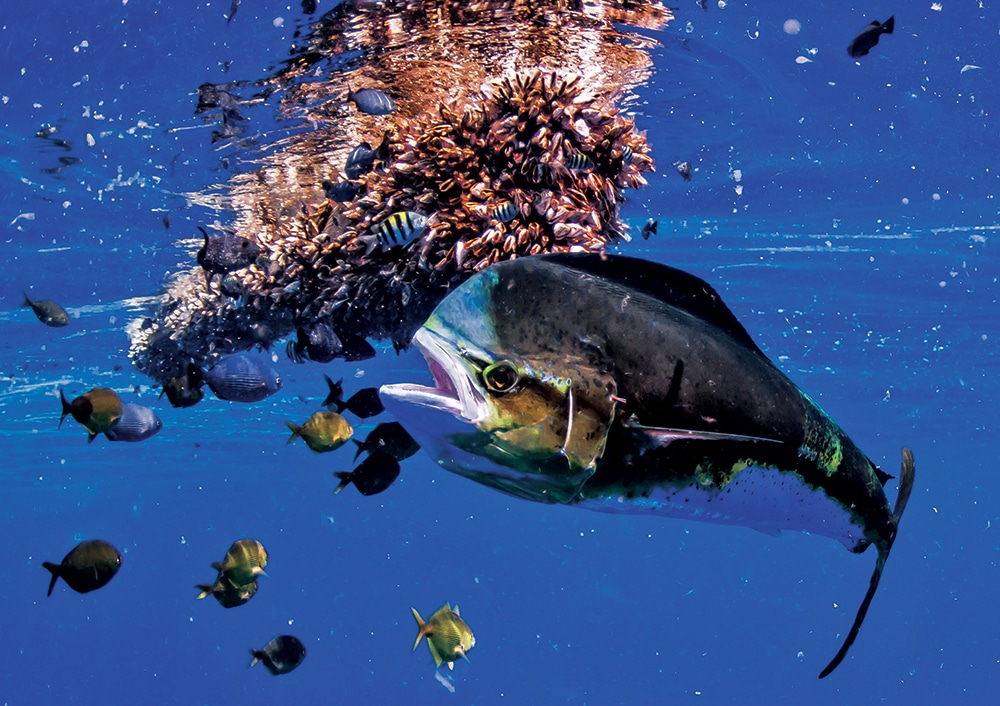
A Curious Attraction to Floating Debris
One of the dorado’s most common behaviors is its attraction to floating debris. Dolphin rely primarily on current edges, weed lines and floating structure for their food, including sargassum and floating kelp paddies. In fact, sargassum weed is often found in mahi stomachs, according to researchers.
Dolphin rely on current edges, weed lines and floating structure for food. There’s no telling what will end up in their gullet.
“They feed primarily on fish, most commonly flyingfish, pufferfish, burrfish, triggerfish and filefish,” says Greg Stunz, of TagPelagic.org. “Crabs and shrimp, juvenile dolphin, juvenile sailfish and sea turtles were also found during a diet analysis of fish recently caught off Port Aransas, Texas.”
Dolphin are such opportunistic feeders that it sometimes gets them in trouble — debris also collects on the sargassum mats. Researchers have found badminton birdies, plastic bottle caps, plastic straps and rope in the stomachs. There’s no telling what’s liable to end up in a dolphin’s gullet.
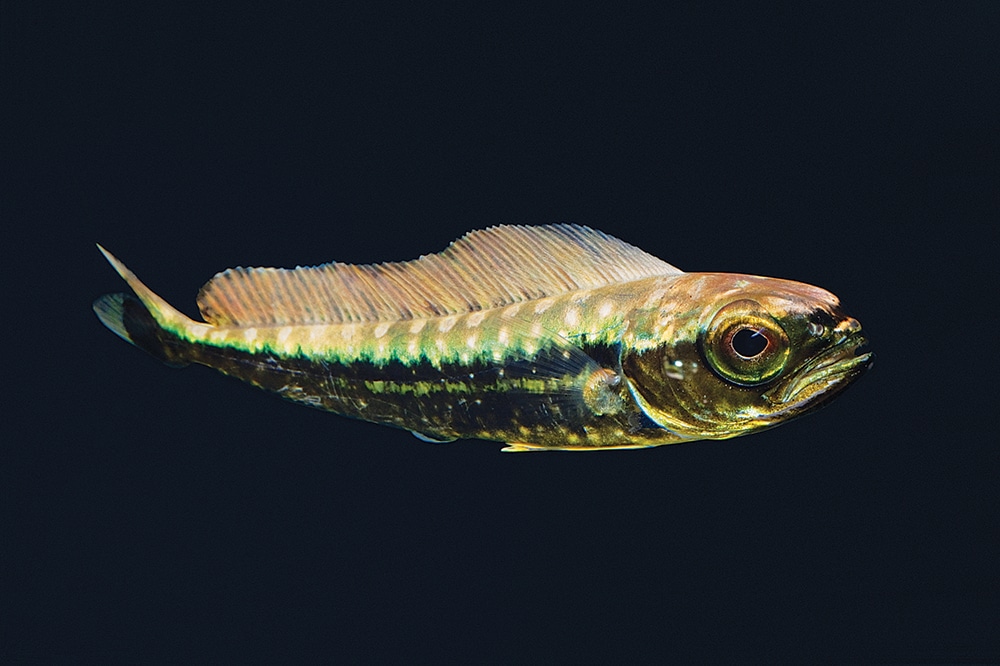
Sex Ed
Males, called bulls, generally grow at faster rates and eat more than females (cows) do. The largest dolphin are always bulls.
The maximum life span of the common dolphin is four years, but 98 percent will not live past two years.
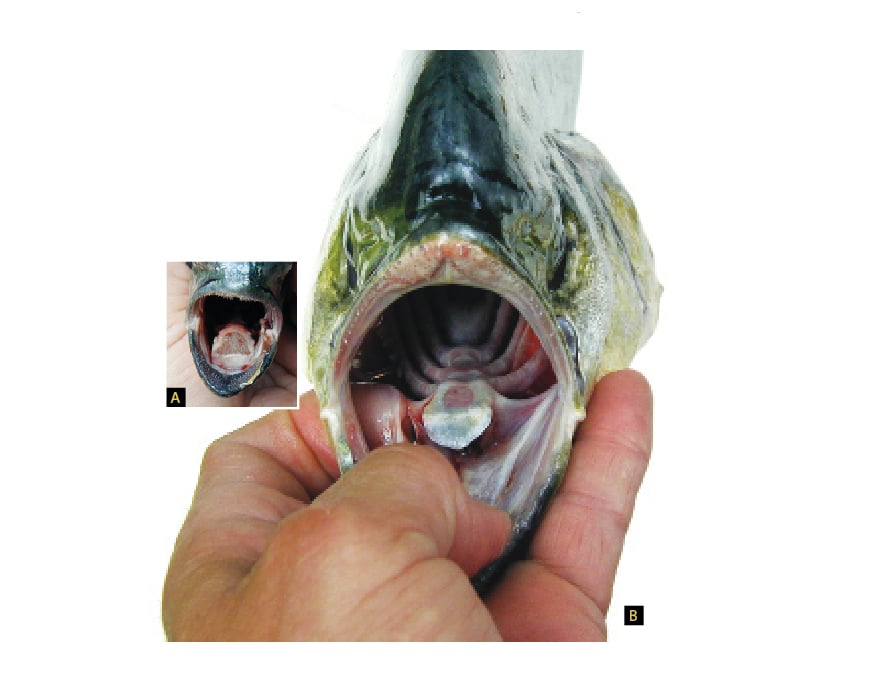
To guess at the age of a fish, consider its length rather than weight. A 6-month-old dolphin could range from 19 inches to 28 inches, a one-year-old could range anywhere from 23 inches to 55 inches, and two-year-olds range from 31 to 55 inches. There’s plenty of overlap when it comes to age.
A less-well-known dolphin called the pompano dolphin, Coryphaena equiselis, is distinguishable from the common dolphin by body depth: The depth of the common dolphin is less than 25 percent of its standard length, while the pompano dolphin’s body depth is greater than 25 percent, according to Florida Museum of Natural History. The pompano dolphin also has a large, square tooth patch covering most of the width of the tongue.
All dolphin reach sexual maturity within a year of growth, sometimes as early as four to five months, or 8 inches in length. And they’re not picky about spawning regularly, as evidenced by the presence of ripe females and larva in waters of the tropics, Florida and the southern Gulf of Mexico all year. Still other areas, such as North Carolina, see spawning fish at least certain times of the year.








